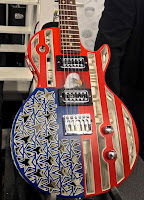Whenever I do clinics at universities I always get a number of questions about home studio construction, since most every musician wants and needs one. One of the most frequent questions is about ways to increase isolation so the neighbors won't hear what you're doing. Here's an excerpt from
The Studio Builder's Handbook that explains the two principles involved in acoustic isolation.
"When building almost any kind of space (especially a home studio), the first question that both musicians and engineers ask regarding acoustics is, “How can I make sure that my neighbors don’t hear us?” There’s really no secret to this one, although everyone thinks there is. All it takes is adhering to the following principles during construction:
Isolation Principle #1 - All It Takes Is Mass
If you want to increase your isolation, you’ve got to increase the mass of the walls and ceiling of the structure that you’re in.
The more mass your walls have between you and your neighbors (that includes walls made from cinder block, brick, wood, drywall, etc), the more you’ll keep the outside sound from getting in, and the inside sound from getting out.
One of the ways that most pro studios accomplish soundproofing is by building a room within a room, which is done by putting the floor on springs or rubber, and building double or triple walls with air spaces in between on top. Needless to say, this gets expensive and is impossible to do if you start out with a small space that’s only 10 foot x 10 foot to begin with since you’ll be left with no room to work in an area that small. But there are other ways to improve your isolation that can really be effective and completely acceptable (though never completely soundproofed) that are quite a bit cheaper.
We’ll go over this a lot more in the following chapters, but here’s basically what needs to be done. All it takes are some construction tools and a little time.
Add some mass to the walls and ceiling to increase your isolation. This could be as simple as adding another sheet of drywall to your existing wall, all the way up to building double studded walls with an air gap in between (see the figure on the left). Before you go nailing up another sheet of drywall and expecting total isolation, you must be aware of some acoustic realities.
Walls are subject to what’s known as a “mass law” that states that every time you double the mass of the entire wall, you get an extra 6dB of isolation, which you can hear but it’s not a huge difference (you can barely hear 3dB). The problem is, you need about 10dB of extra isolation for the sound to subjectively decrease by half. This means that you need about four times the mass to get only half as loud, which is not nearly enough to isolate something like a rock band.
To put it another way, if you add another sheet of 5/8 inch drywall to your single stud wall, have a listen and decide it’s not nearly enough isolation, you have to add six more layers (for a total of eight) in order to cut the sound in half. And that assumes that there are no leaks in the wall and the sound isn’t going through another path such as the ceiling, floor, side wall, or window, in which case NO amount of extra drywall will help.
You can see the limitations of just adding more and more drywall. First of all, there comes a point in time when the wall just gets too heavy for the underlying frame, and as you’ll see, there are much more efficient methods to increase the isolation.
Unfortunately, there is just no easy or cheap way to isolate a room. The easiest way is to use what’s known as “mass-spring-mass” or MSM walls, which means you have a wall (the mass), then an air space (the spring), then another wall (the mass). That gives you a double stud wall, which is essentially a room within a room (see the figure on the left again).
Isolation can be increased slightly by sound damping products like Green Glue and resilient channel (see Chapter 5 for more details), but mass and MSM walls are still the best way to get some major isolation. This brings us to Principle #2.
Isolation Principle #2 - Leave No Air Gaps
Isolation can be easily defeated by air gaps anywhere in the room.
Think of air like water.
If you fill the room with water, any space between any construction joint would let the water (or air) leak out, so the idea is to make sure that there are no air leaks.
Leaks that allow the sound to violate the isolation is called “flanking transmission” and is a major cause of poor isolation. You can have four foot thick concrete and MSM walls but you can negate those benefits if there are air-gaps anywhere in the room. This is especially true for doors, which are the greatest culprits for acoustic leakage, but can also be true of windows and seams between drywall. There can be no air gaps if you want maximum isolation, it’s as simple as that. It’s best to use an acoustic sealant on these spaces because it doesn’t break down with age, but any kind of caulking will work in a pinch. It’s also important to have a tight seal around any light fixtures and on-off switches, AC outlets, mic panels, wall junctures, and HVAC vents.
Sometimes, just eliminating the flanking transmission can increase the isolation by more than you think, so make it a priority."
The big problem with isolation is that the principles are easy but they're labor and materials intensive so they cost a lot. Luckily, acoustically treating the room is much easier.
----------------------------------





